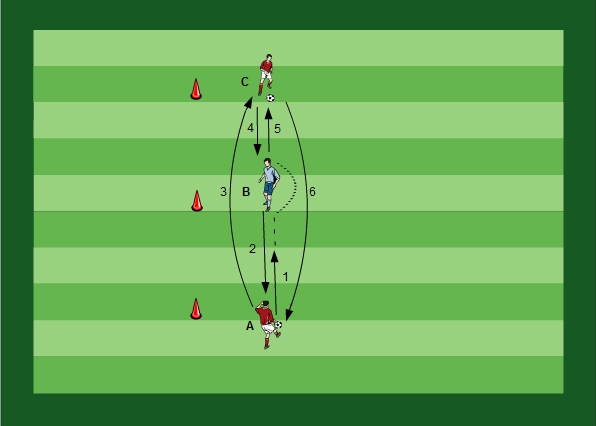Progressive Combination Passing I
-
Process
Passing between the three players. A passes on the ground to B, who comes to receive the ball and lays the ball back to A then passes a long ball to C who lays the ball off to B. B ten lays the ball back to B awho passes a long bvall back to A. This pattern can be repeated as often as required.
-
Tip
3 cones, - Precise, exact passing is extremely important for successful soccer. As a result passing should be regularly practised. It is important not to forget to correct mistakes and give correct demonstrations. - This exercise requires a high pass precision and exactness - The player in the middle will tire after continued play. As a result the players should change positions every 60 seconds. Further important Characteristics: - The standing foot should be 30-40cm to the side of the ball, in line with the ball. - When passing with the instep, the toes should point upwards, the ankle joint should be tensed and the upper body slightly leant over the ball. - Stand on the balls of your feet, the passing foot should be slightly raised to strike the ball in the middle. Bring your body over the ball and don't lean back. (Ball control is achieved using the same technique). - The foot should follow through after striking the ball. - Movement of the arms is important: When passing with the right instep the left arm should cross to the right hip; when passing with the left instep the right arm should cross to the left hip. - The player can lean back slightly when passing with the outstep. - When passing with the ball of the foot, the player approaches the ball diagonally with his body slightly side onwards to the ball.
-
Field size
Distance horizontal: 10 - 16 meters Distance vertical: 4 meters
-
Cone margins
Distance 5 - 8 meters
Training Set
Duration
Age
Technique
Tactics
Co-Ordination
Condition
Set plays
Training Organization
Number of Players
Goalkeeper
Form of Training
Position training
Exercise level
Spatial Behavior
Training Location
Author: Christian Titz
More exercises
|





